|
|
Page 12 Pages (1) (2) (3) (4) (5) (6) (7) (8) (8a) (11) (12)
Nouvelle Maison - Jules Huet & Cie - 20 x50
Introduction
1. Historical notice
2. Body description
3. Technical data
The readers’ annotations
Introduction
We would like to introduce the next French binocular from our collection – Nouvelle Maison – Jules Huet & Cie 20 x 50.
The binocular of this magnification was hardly ever seen among binocular collectors. A related model 16 x 40 is popular among collectors.
By kindness of Ulrich Zeun, we were able to gather some information about this model.
 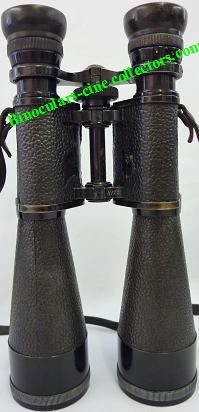 
20 x 50 Nouvelle Maison Jules Huet from our collection; Copyright pictures Anna Vacani
1. Historical notice
The binocular was produced in 1913, as the last owner – John Duro, described on the picture of the binocular, enclosed with the glasses.
It looks as the binocular was produced later then 1913, presumably just after the war in 1919.
It was manufactured by the Nouvelle Maison – Jules Huet & Cie Company in Paris at 25-27, Rue de la Grange – aux – Belles. Manufactured and supplied to Ministries of War and Navy (Des Ministère de la Guerre et de la Marine).
As far as today no French enthusiast has written the history of the Company, Jules Huet. The Company, Jules Huet many times united with other Companies. It is only visible in some advertisements published for decades.
Ulrich Zeun has written about the Company: “The "Nouvelle Maison ..." operated since 1913 until the 1920s, then was renamed to just "Huet" and changed to the sort-of triangular logo, resembling a prism.”
 |
Huet advertisement ca 1931- 1933
The binocular 20 x 50 was described in the Company catalogue, published in 1919.
Jules Huet & Cie catalogue 1919, kindly sent by Ulrich Zeun
2. Body description
The body is built from brass and aluminium alloy. In the pictures below, it is visible which parts are made from the brass. The owner of the binocular polished all paint from the brass parts.
 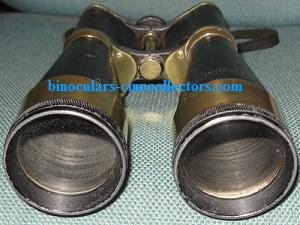 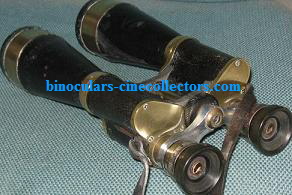

Pictures have been found by Ulrich Zeun
The binocular body is covering with black vulcanite plastic leather. The cover is cracked in the same places as on the other binoculars covered with this material. Fractured in points where glasses were held by viewers.
The brass parts are covering with black shiny paint (lacquer).
The description of the binocular are engraved in the brass plates.
 
Left and right plates of 20 x 50 Nouvelle Maison Jules Huet from our collection; Copyright pictures Anna Vacani
On the left site is given the year of the Company establishment – 1913.
The production number – 8172, is placed on the bottom hinge of the binocular.
 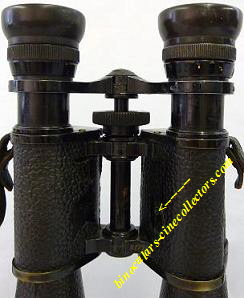
Production number of 20 x 50 Nouvelle Maison Jules Huet from our collection; Copyright pictures Anna Vacani
The eye lenses are small – only 10 mm diameter. The Bakelite eyecups do not have damages.
As it visible in the above pictures, the 20 x 50 model is central focusing.
Unfortunately, the right ring with a diopter scale is a little destroyed when it was unprofessionally serviced. The scale is not clear.
Eye lenses of 20 x 50 Nouvelle Maison Jules Huet from our collection; Copyright pictures Anna Vacani
The eyecups and objectives rings are made from aluminium alloy and very nicely finished with vertical notches.
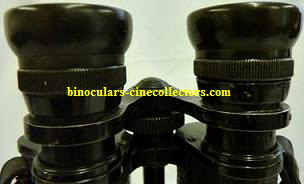 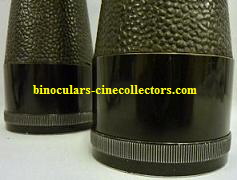
Eyecups & objectives rings of 20 x 50 Nouvelle Maison Jules Huet from our collection; Copyright pictures Anna Vacani
The binocular body is in very good condition and it looks very stylish. It is very convenient to hold the binocular, because of its good balance. The full length of body is 24 cm (9, 44 in).
3. Technical data
The binocular technical description, placed into the catalogue from 1919 is in a very old technique.
Jules Huet & Cie catalogue 1919 sent by Ulrich Zeun
The magnification is specified in linear - x 20 and in square surface – 400.
In the Goerz catalogue (in our collection), published in 1903 we can read the explanation of that description : “Any optical system which endeavors to render the image of distant objects even more distinct than when seen by the naked eye, must do so by widening the angle of view. This process can be expressed in figures. A telescope has a 4x magnifying power if the object seen through it appears four times larger than when observe at the same distance by the naked eye. This is linear magnification, the magnifying of one dimension only. But as the object appears increased in height as well as width, we speak then of the superficial magnification, - the enlarging of both dimensions at once. This equals the square of the linear magnification, so that a linear magnifying power of 4x produces an image of sixteen times the original surface area. “
Other description as “Luminosity”, after 1960s there was no longer used.
The exit pupils are 2, 5 mm.
The complete binocular description emphasized that this binocular has perfect sharpness, full seal, considerable field of view and unique brightness.
Further in catalogue, it says: “EFFECT STEREOSCOPIC. - The relief of an object being due to the difference in angle at which each of our eyes see the object, this relief is still growing with our Binocular Stereoscopic, whose objectives are spaced further apart than the distance between the eyes. Our binoculars are variable spacing of ocular which allows the viewer to be able to adjust the spacing of the viewers’ eyes The simultaneous focus is achieved through a centre wheel, which allows adjusting quickly and having clear pictures at any distance. The right eyecup is graduated to allow perfect correction of irregular eyes. Our binoculars are absolutely guaranteed. Any instrument that does not give full satisfaction will be exchanged within eight days from the date of receipt. ” – translated by Google.
The shape of the prism house is similar to a short binoculars produced at that time only the hinges are placed in different position. They are placed just below of the top cover plates and just over the bottom covers.
Looking into differences between model 16 x 40 and 20 x 50 is the measurement of the objectives tube, which is 3 cm (1,18 in) shorter.
The model 16 x 40 is described in Dr Hans Seeger “gray”(4th on the list of literature) book, page 79. That pictured binocular was used during the WWI; it has a British Army symbol, letter and number: S1. This description does mean that the binocular was qualified as “First Grade prismatic binocular”. Read more about this symbols – Binoculars - > Unusual - > page 7 “Marine Revolver...” The model 16 x40 is not in our collection, but was seen in our house very often. This model has got a peculiar aliment and fittings of the prisms.
The Porro I prisms are held in place only by plaster of Paris (gypsum) with no metal retaining strap. As a consequence the plaster of Paris must be cut away to remove the prisms for cleaning and then it will be impossible to stick back the prisms, in a correct position without a factory aliment collimating tool. The plaster of Paris is very difficult to remove.
In this way, with that experience our binocular 20 x 50 was not opened. We are fortunate that the binocular is very clean inside.
Carl Zeiss Jena was using this plaster of Paris to cement the bottom and top strengthen glass plates on Porro II binoculars models: 7 x 50H, 8 x 60 H; 8 x 60 slim model; UDF 7 x 50.
The model 20 x 50 was produced as a monocular as well. Ulrich Zeun is given full description of that monocular on his web site;
http://www.monocular.info/huet20x50.htm
The monocular model looks as it is a half of the binocular. Only the description of the monocular is a little different, on the top plate of the prism housing. The words “Telescop x 20” is added to the main description.
The description of the Monocular 20 x 50 from Ulrich Zeun collection; Copyrights picture Ulrich Zeun
As Ulrich Zeun says, the production number is not visible on the monocular model.
If the readers of this short article would like to add any additional information about the 20 x 50 Nouvelle Maison Jules Huet Cie model, it will be nice to hear and to insert into the article.
The readers’ annotations
1. Keith Robinson says:
“Regarding the Huet 20x50, my only comments are that, first, the manufacturer’s table (Characteristique) shows that the 20x50 has a vastly superior apparent field of view to that of the 16x40! (60*.v.48*). This is surprising, seeing that the military classification of the 16x40 is S1, which includes in its definition having excellent field of view. But 48* is hardly excellent contrasted with the 60* they achieved on the 20x50. Second, it goes [...] that the military requirement of the 16x40 is for individual eyepiece focussing as opposed to the centre focus of the 20x50.”
Page Back Pages (1) (2) (3) (4) (5) (6) (7) (8) (8a) (11) (12)
|
|